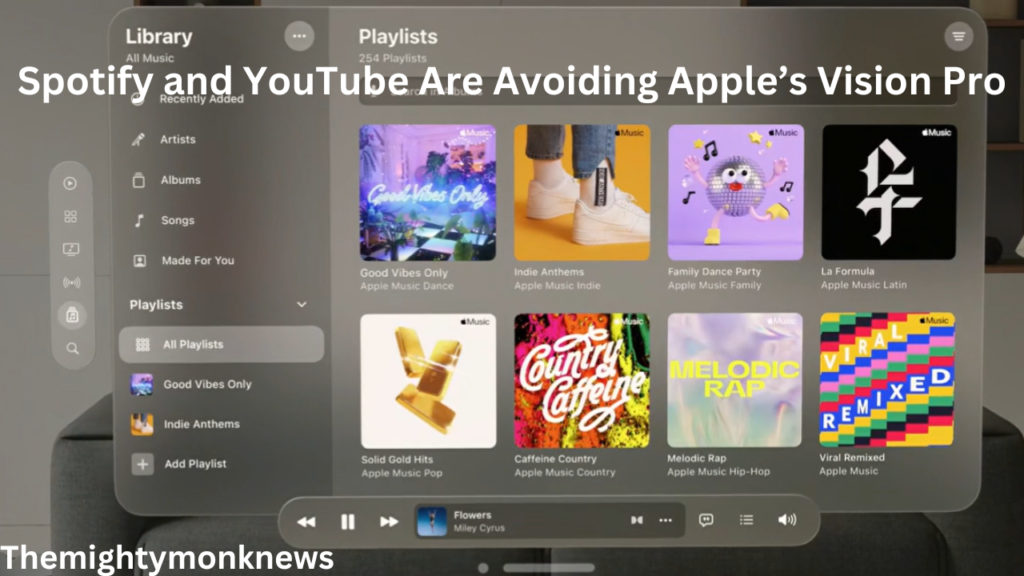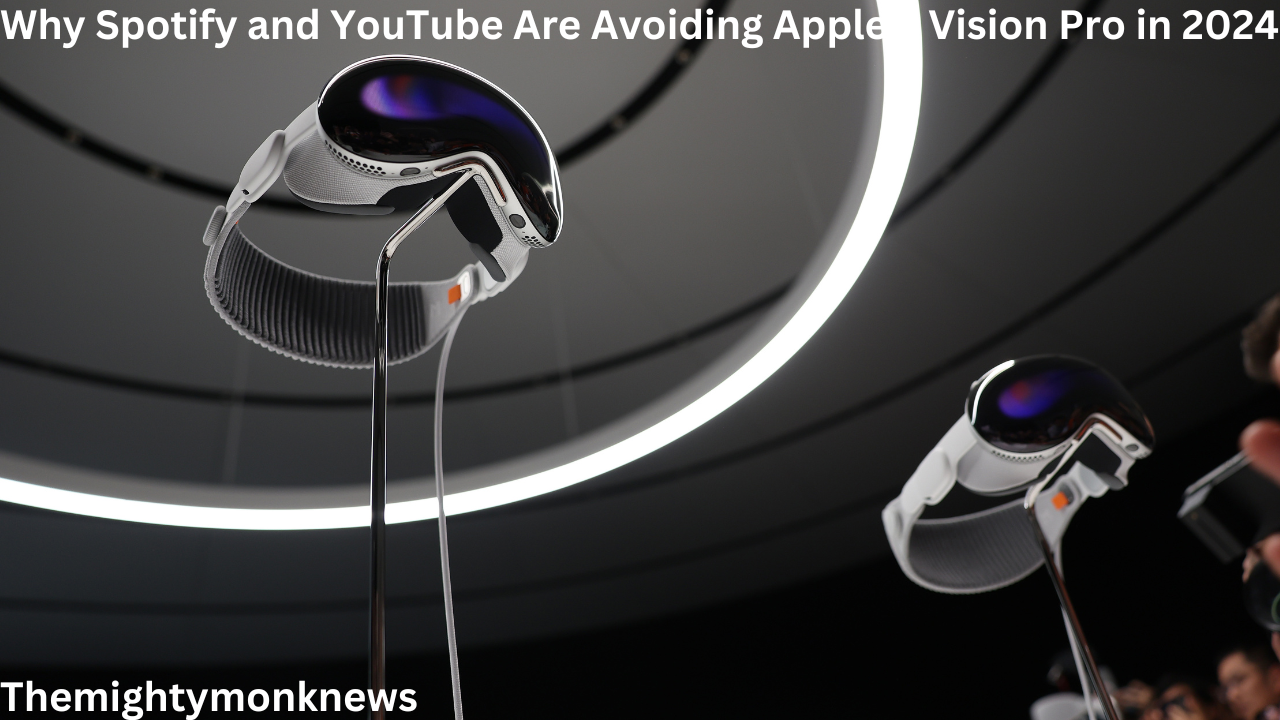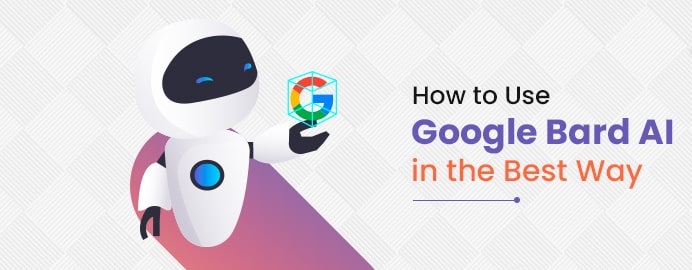Apple’s much-anticipated Vision Pro headset is on the verge of its launch, promising an immersive “spatial computing” experience that could potentially revolutionize our interaction with digital content. However, there’s a setback to the headset’s appeal as streaming giants Spotify and YouTube have opted not to release dedicated Vision Pro apps. Instead, they are steering users to access their services through the Safari web browser.
This raises a critical question – why are these streaming services reluctant to fully embrace the ambitious vision for spatial computing presented by Vision Pro? And what implications does this hold for you, a potential buyer of this premium $3,499 headset? In this comprehensive article, we delve into the likely motivations behind Spotify and YouTube’s unexpected decisions, explore the potential impact on the Vision Pro experience due to the absence of dedicated apps, discuss the possibility of these companies altering their stance in the future, and, most importantly, analyze the implications for you.
Why Spotify and YouTube Choose Not to Develop Dedicated Vision Pro Apps.
Limited Addressable Market
Limited Addressable Market With its premium starting price of $3,499, Apple’s Vision Pro naturally targets a small segment within the overall tech market. Industry analysts predict sales in the low hundreds of thousands for 2023 – a stark contrast to the multi-million unit sales achieved by devices like iPhones.
For mass-market services such as Spotify and YouTube, which cater to billions of users worldwide, investing resources in developing dedicated apps for niche devices appears impractical, regardless of the advanced technology involved. Without widespread adoption reaching multiple millions of users, the return on investment becomes questionable.
A similar scenario unfolded previously when YouTube declined to create a Windows Phone app back in 2012, despite public requests from Microsoft’s executives. The minimal market share of Windows Phone led YouTube to doubt the feasibility of attracting enough users to justify allocating limited engineering resources to the platform.
Limited Immersive Use Cases
Music and video apps don’t necessarily experience significant transformative benefits when ported to dedicated VR/AR headsets compared to projecting 2D screens. The fundamental experience of listening to music or watching videos remains largely unchanged, even when the visual presentation transitions to 3D environments.
This contrasts with gaming and specialized VR apps that can completely overhaul gameplay, visualization, and user interaction by fully exploiting the expanded canvas.
For Spotify and YouTube, the bottleneck is primarily focused on audio and fixed rectangular video formats. They likely don’t perceive enough added value in porting these assets into VR when compared to simply projecting them as floating 2D panels via the browser.
Unless they decide to create VR-specific music visualizers, interactive video portals, or custom virtual spaces in the future, the incentives to allocate scarce developer resources for optimization on platforms like Vision Pro will likely remain minimal, regardless of the capabilities of Apple’s headset technology.
Competitive Concerns
YouTube, in particular, has reasons to be cautious about prioritizing Apple’s platform, considering its direct competition with Apple Music, Apple TV+, and other Apple subscription services.
Granting Apple’s hardware exclusive access to an immersive YouTube app might inadvertently contribute to the promotion of Apple’s competing services, which can seamlessly integrate into the company’s closed ecosystem. This scenario has unfolded over decades as Apple consistently prioritizes its own services over competitors on iOS.
Having faced extensive antitrust battles globally related to these anti-competitive practices, YouTube is likely hesitant to readily bring TikTok-style short videos into Apple’s new platform without assurances of fair competition.
Microsoft encountered similar challenges a decade ago when it worked diligently to create quality YouTube apps for Windows Phone, while Google’s slow development hindered adoption. This bitter experience taught Microsoft about the substantial risks associated with relying on competitive third-party platforms it doesn’t control. YouTube appears determined not to replicate this situation.
The Impact of Absent Dedicated Apps on Your Vision Pro Experience

Without tailored Vision Pro apps, YouTube and Spotify will need to be accessed via the Safari web browser which will provide a more basic, pared down experience compared to using the slick Apple Music or Apple TV+ apps expected to launch alongside specialized third party apps at release.
Here’s specifically what you’ll be missing out on:
Limitations in Immersive Environments
While Apple’s Vision Pro promises immersive virtual worlds, accessing YouTube and Spotify through Safari lacks the tailored environments offered by dedicated apps, limiting the full spatial experience.
Absence of Interactive Elements
Safari browsing on Vision Pro lacks the intuitive hand-tracking controls provided by dedicated VR apps, reverting to less immersive cursor-based interactions, hindering seamless user engagement.
Deprivation of Enhanced Video Formats
The absence of dedicated apps for Vision Pro means missing out on immersive VR-specific video formats on platforms like YouTube. The lack of 3D, 180°, and 360° videos limits users to traditional flat 1080P content.
Suboptimal Performance and Lack of Optimization
Without device-specific apps, streaming content through generic web browsers may lead to performance issues, buffering delays, and visual artifacts on Vision Pro. Dedicated apps provide optimization, leveraging foveated rendering, caching, and framerate management for an enhanced immersive experience.
Will Spotify and YouTube Reconsider Their Decision for Vision Pro Apps in the Future?
Spotify, YouTube, and even Netflix might consider making apps for the Vision Pro headset in the future. According to Bloomberg, these companies are waiting to see how well Apple’s headset does before deciding. If the Vision Pro headset sells really well and gets support from major entertainment brands, Spotify and YouTube might make apps for it. This might not happen until at least 2024. In the past, Spotify and YouTube were not available on early Apple Watch models but were added later. Things can change over time. Apple’s TV sets faced similar challenges with getting support from media companies. So, while Spotify, YouTube, and Netflix might not be eager to support Vision Pro in its early years, this could change if Apple’s headset becomes very popular. For now, they are playing it safe by offering basic browser access, just in case.
What Does All of This Mean for You?.
At the end of the day, should Spotify and YouTube refusing to build dedicated launch apps for Vision Pro factor into your purchasing decision if you’re interested Apple’s flashy headset? Let’s weight the pros and cons:
Reasons these missing apps may not matter hugely:
- Vision Pro will still feature a thriving app ecosystem from day one anchored by Apple staples like Apple Music, Apple TV+, Safari etc. There will be no shortage of stuff to watch or ways to get immersed.
- You still retain basic Spotify and YouTube access via mobile-centric web interfaces. It’s not perfect, but tables stakes functionality remains
Conclusion :
At almost $3,500 before accessories, Apple’s Vision Pro was always going to be a dramatic side grade for iPhone users satisfied with more mainstream tech gadgets. But the lack of key streaming video and music apps from day one casts further doubts that Apple’s first headset can live up to its lofty promises as critical launch partners apply the brakes.





